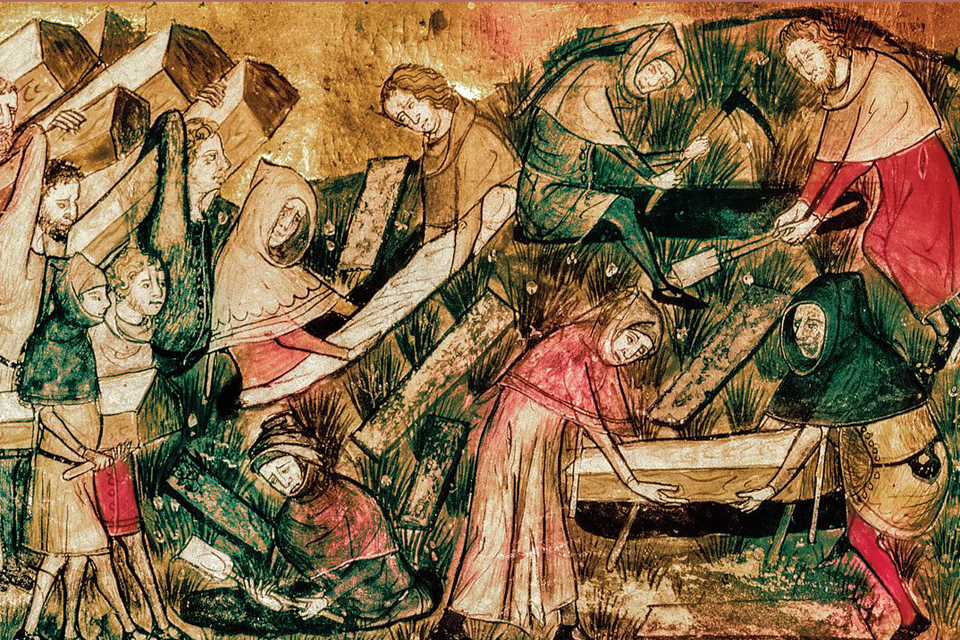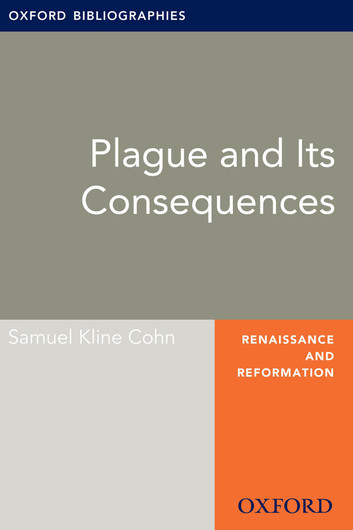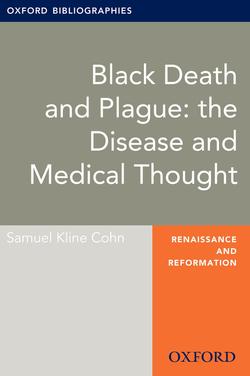Was the plague brought to people by rats or human lice? How severely did the pestilence strike? What may we learn from modern epidemics? New research shed light on some old conundrums.
For years a scientific and scholarly warhas raged as to the nature of the epidemics in 14th and 15th century Europe. Were they outbreaks of plague, or were they cases of flu? Some years back, of course, the identification of the plague bacteria, Yersinia Pestis, and the reconstruction of the genome in 2011 laid much of this debate to rest. Numerous other questions were, however, raised by this scientific discovery. Especially the question of how the pestilence spread? By rats as the old story was? Or infectious human droplets coughed up by the sick and dying?
Several studies have indicated that neither explanation seems satisfactory. If rats were the vectors, how come the streets were not filled with dead rodents? (A feature missing in both written accounts and archaeological excavations). And how come the plague hit Norway where the climate does not support rodents on a massive scale? And – in case the plague was carried by droplets – the question remains why even solitary and peripheral settlements seemed to be hit just as severely?
Plague and Pestilence in Norway

In a new article [1], Norwegian scientists have explored the way in which the epidemics might have played out if it was carried by human fleas and lice. Studying nine specific outbreaks in Europe – Givry, Florence, Barcelona, London, Eyam, Gdansk, Stockholm, Moscow and Malta – from 1348 – 1813; all of them known for the documentary evidence as to their weekly spreading. The study is a theoretical analysis based on a model comparing what the result would have been if rats, droplets or fleas and lice were the main culprits or vectors. The model captures the dynamics of human ectoparasite transmission best in seven out of the nine cases. “Overall, our results suggest that plague transmission in European epidemics occurred predominantly through human ectoparasites, rather than the commensal rat or pneumonic transmission”, write the scientists. They do notice, however, that the likely route for transmission might have been mixed. In modern outbreaks, 20% of plague-victims might develop pneumonic plague leading to a more complex route for the spread of the infection. Also, the third pandemic (from the 19th century) was obviously dependent upon rats as the vector.
These results fit nicely with the conclusions, which a somewhat overlapping group of Norwegian archaeologists published in 2013 [2]. They argued that rats could not be the vector in Norway and other Nordic countries in the Middle Ages. Written records provide information about 26 epidemics in Norway and Sweden between 1349 and 1654, some of which would spread to most of the peninsula including the interior. An archaeological survey has revealed a striking lack of rat bones in archaeological excavations, especially in the interior, making it highly unlikely that black rats were the vectors of the disease. However, this was already argued in a survey from 1990. Nevertheless, estimates derived from the work undertaken in the 1960 – 80 have established that not only did the pestilence set its mark on the cities and towns along, the coast. It also reached far into the interior. All-in-all, it is believed to have killed between 40-50% in its path contributing to a near collapse of the Norwegian society. Slightly below the famous assessment of Einar Haflidason, who wrote at the time of the events that no more than one-third of the Norwegian population survived the first wave in 1349–52. Modern estimates tell us that there were approximately 73,150 peasant holdings in operation in the first half of the 14th century with a probable total population 350.000 (including 15.000 in the towns and cities.
Decline in building activities in 14th century Norway
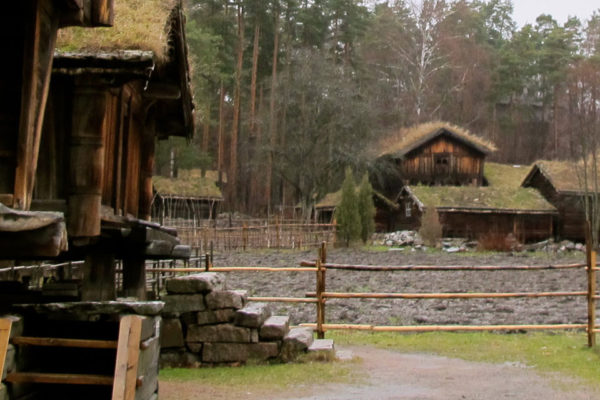
New research [3], however, indicates that the decline in population probably took its beginning earlier on. Evidence of this comes from studies of preserved medieval buildings as well as the timber provided from still existing buildings, which may be used when constructing tree-ring chronologies. Apart from a significant hiatus in preserved buildings from the decisive years, a shift in the use of building techniques also indicates a substantial loss of technological know-how. A survey of more than 1000 preserved medieval buildings in Norway nevertheless shows that this decline in preserved buildings – which because of dendrochronology may be dated rather precisely – set in slightly earlier, indicating that the demographic crisis was also forced by climatic shifts. Of the 1000 buildings, of which several hundred were built before 1300, only four buildings have been dated to the period between 1300–1350. No buildings are dated to the second half of the 14th century and only eight to the 15th century. There was apparently a significant dearth of new building activities in the 14th and 15th centuries. Also, it set in before the events of the black death. Another interesting fact is that when building activities once more commenced, the timber used had obviously grown in a different kind of forest; as indicated by a double tree-ring width, yet half the number of rings. The explanation offered by Terje Thun and Helene Svarva is that these trees were sourced from deserted infields and “gards” or “tuns”, which had offered well-fertilised growing opportunities. However, the shifts in the width of tree-rings also indicate that numerous less fertile years abounded in the late 13th and early 14th century. It is likely that the devastating demographic contraction, which occurred after the plague arrived in Bergen in 1349 had in fact started at an earlier time. Also, that it might have been caused by climatic shifts, as has been argued elsewhere. This study invited us once more to take a cautious attitude towards the estimates of the impact of the Black Death later in the 14th century [4].
Dangers of Noncritical Use of Historical Plague Data
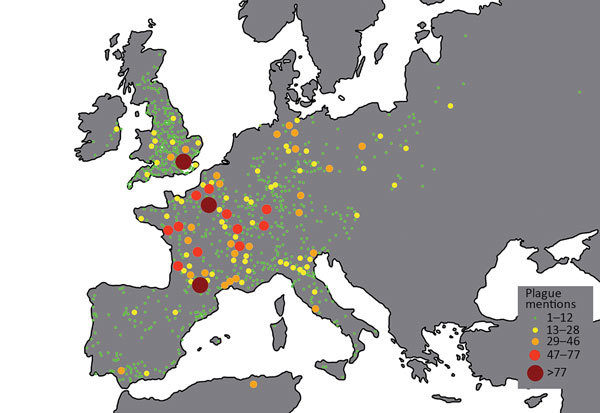
To a large extent, Norway has always been considered a paradigmatic case. Because of the very detailed history of settlements combined with archaeological excavations and written material, we know pretty well how devastating the crisis in the 14th century seemed to be, even though it may be complicated to figure out exactly to what extent climatic shifts versus the pandemic contributed.
Not so elsewhere! Overviews of the significance of the 14th-century pandemic seem to some extent to continue to build on old and patchy demographic data collected in 40 years ago by Jean-Noél Biraben in his two-volume work: Les Hommes et la Peste en France et dans les pays méditerranéans 1347 -1352 and later expanded in a collaborative database. This use of this patchy and mainly anecdotal database however, invites serious challenges [5] First of all, the material is naturally skewed as France appears as the epicentre. Obviously a reflection of the fact that Biraben was Frenchmen, this means, for instance, that the outbreaks in the Low Countries, as well as Scandinavia, are absent. Even Italy figures only sporadic in this material. Also, some research results – e.g. the interesting hypothesis of a correlation between waterways, rivers and outbreaks skews up, because so many individual cases, where this linkage might be identified – or not as in for instance Norway – have been left out of the equation. Elsewhere, for instance, in the Netherlands, the slanted material has made it possible for historians to claim that plague had little or no impact despite the fact that the region was one of the most densely populated in the Late Middle Ages
Black Death in the Netherlands

By Joris Roosen and Daniel R. Curtis. In: The Economic History Review (2018). First published 05.02.2018 (Open Source)
Such was the case of the curious “denial” played out in the 1950’s among historians in the Low Countries. The object was the impact of the Black Death in the Netherlands, and more specifically the south. Although historians have subsequently refuted this as nonsense, the idea still lingers that one of the most densely populated corners of Europe somehow got off easily. Some have claimed that hunger and famine caused significant more devastation, while others have argued that the echo-epidemics in the late 14th and the beginning of the 15th centuries were the real culprits.
All this, however, poses a serious conundrum. Why would the Black Death strike so lightly in present-day Belgium, if it hit the surrounding regions and countries so hard – especially France to the South?
In a recently published article, Joris Roosen and Daniel R. Curtis [6], have not only sifted through the old sources, but also explored a new database of mortmain accounts. In this connection, Mortmain means a death fee on possessions paid by a very substantial subsection of the population (only French people, high nobles, and religious professionals were exempt. More precisely the authors have exploited a new database registering 25.610 individuals from the region of Hainaut 1349–1450. Although reservations remain as to the comprehensive character of the material, it does help to fill out the many micro-studies carried out in specific places, for instance, religious institutions. Also, the register does not count the cases from all districts at all times. Nevertheless, the database does provide us with the ups and downs of mortality rates. More specifically, it shows that during 1349, the second year of the first wave of the plague the number of deaths had doubled up. But evidence points to a situation where recordkeeping could not keep up with the events. Later plagues caused 3 to 4-year spans, in which the mortality rates doubled or even (nearly tripled). (The fluctuations are based on the increase and decrease from the average number of mortmain per locality 1349–1450). Matching micro-histories with the figures drawn from the mortmain database suggests that plague outbreaks occurred in 1349–51, 1358–63, 1368– 9, 1380– 81, 1400–1402, 1425–6, and 1438–9.
Was this a distinctly urban phenomenon? No, writes Roosen and Curtis. In fact, studies of numbers of households, which went vacant during plague years, tells us the toll was heavy. Unfortunately, it is difficult to know exactly how massive, since the decimation of cities caused a significant migration from rural to urban settings. The plague did indeed strike as heavily as should be expected in such densely populated region as the large cities in the Low Countries. Somehow, though, this was never as visible in the older accounts due to the overreliance on urban sources. It appears one of the results of the recurrent epidemics was that towns and cities of the might have been quick to replenish their population by welcoming migration from the devastated countryside; thus masking the size of the demographic crisis in the long-term. Also, cities were bent on trying to play down the severity of the disease. Should competing and neighbouring towns know of the depletion of the population, they might get on top of the commercial game. This might bode for economic ruin. Further, it may also be a contributing factor that written accounts became scarce. Who should keep the registers, if the clerks or accountants had died? Finally, we know that the average age of marriage was followed by increased fertility.
To conclude: it may have been the received wisdom at some point to imagine that the plague did not hit the Low Countries as severely as elsewhere. New research demonstrates, though, that this was not the case. Mortality rates were as severely heightened as elsewhere, albeit they were probably masked by widespread migration from the countryside and into the towns and cities as well as – perhaps – altered norms for marriage age and fertility.
Stress, Sex, and Plague in London
Did people get wealthier after the plague? Undoubtedly. We cannot even begin to imagine the relief of being able to filch the flea-infested clothes of your dead neighbours, at a time when spinning and weaving were one of the huge and probably often impossible tasks to find time and energy to carry out in households on the brink of economic disaster; especially, if the filching took place in wintertime with the bugs dying from cold!
What also changed was seemingly the physical and bodily improvement of the general living conditions and circumstances. Recently [7], this point has been made again in a detailed study of three samples of skeletons from London cemeteries. More precisely, the remains of 255 individuals from the period 1000 – 1200, 247 individuals from 1200–1250, and finally 329 from the period 1350–1540. The study aimed to identify the age, the sex, and the survivorship, as well as estimate developmental stress markers in the teeth (Linear Enamel Hypoplasia) and the adult stature.
The study shows that people before the Black Death experienced gradually worsening living conditions after 1200. This was obvious as to both stature and to some extent survivorship. Concerning developmental stress as measured by Linear Enamel Hypoplasia, though, the pattern was slightly different. While boys obviously experienced worse conditions while growing up after 1250, and a corresponding betterment after 1350, such was not the case with girls.
In terms of stature, they were even able to secure an advantage. The average length of their tibiae grew with nearly 20%. After the outbreaks of plague, it seems, the girls fell back to their former stature. What does this tell us?
First of all, the study demonstrates that post 1350 less fortunate individuals had died leaving an overall healthier population of males around. Scrawny individuals had been taken first. For females, however, the situation was not quite as favourable. It seems that girls did not experience a change in the developmental stress as measured by Linear Enamel Hypoplasia pre-1350. After the outbreaks of plague, though, they seem to have been less sheltered. Perhaps they were able to get more titbits out of their mothers or by stealing from the pots in the period up to 1350. Afterwards, they may have been more on their own; and perhaps dependant on hungry brothers. As we know, they also lost out as to their height and did not experience quite as significant an increase in their overall survival as did the boys.
The most likely explanation, though, is that the surviving females were not significantly worse off after the plague broke out than before. It is likely, however, that they were perhaps impregnated at a much earlier time in their life, than would have been the case before 1350, thus halting their growth post-1350. The authors also argue that their health improvement may also have been accompanied by an earlier set-in of their menarche.
In this context, though, it is perhaps important to note that a staggering 53% of males and 60% of females did show signs in their teeth of havering suffered famines and malnourishment even after 1350. The figures in the immediate pre-black death period were 78% for males and 67% for females. Conditions got better and clothing probably warmer. Nevertheless, life was still nasty, brutish and short!
Conclusion
For many years, historians have waged wars as to the numerical, economic, social and cultural impact of the Black Death. Was it as devastating as reporting says? How did it play out? Did it, primarily, ride on the back of a slow and grinding crisis, which set in at the end of the 13th century? Or did it create havoc all on itself? New sources and new ways of approaching the existing data are not as yet yielding more complete overviews. On the other hand, the diligent reworking of written sources as well as archaeological evidence from specific regions seems to provide us constantly with better insights.
The articles, refereed above, are witnesses to this.
Notes and Sources:
[1] Human ectoparasites and the spread of plague in Europe during the Second Pandemic
By Katharine R. Dean, Fabienne Krauer, Lars Walløe, Ole Christian Lingjærde, Barbara Bramanti, Nils Chr. Stenseth and Boris V. Schmid
In: PNAS. Proceedings of the National Academy of Sciences of the United States of America.
First published 16.01.2018 (Open Source)
The article is based on the thesis by Katherine R. Dean from 2015: Plague transmisson in Medieval European Cities. University of Oslo 2013
[2] Rats cannot have been intermediate hosts for Yersinia Pestis during medieval plague epidemics in Northern Europe
By Anne Karin Hufthammer and Lars Walløe
In: Journal of Archaeological Science, Volume 40, Issue 4, April 2013, Pages 1752-1759
[3] Tree-ring growth shows that the significant population decline in Norway began decades before the Black Death.
By Terje Thus and Helene Svarva
In: Dendrochronologia (2018) vol 47, p. 23 – 29 (Open Source)
[4] See also: Climate-Driven introduction to the Black death and sucessive plague reintroductions into Europe.
By B. V. Schmid, U. Büntgen, W. R. Easterday, C. Ginzler, L. Walløe, B. Bramanti, et. Al.
In: Proceedings of the National Academy of Science USA (2015) Vol 112, p. 3020 – 25
[5] Dangers of Noncritical Use of Historical Plague Data
by Joris Roosenand Daniel R. Curtis
In: Emerging Infectious Deseases (2018) vol. 24 no. 1, pp. 1003 – 110 (Open Source)
[6] The ‘light touch’ of the Black Death in the Southern Netherlands: an urban trick?
By Joris Roosen and Daniel R. Curtis.
In: The Economic History Review (2018). First published 05.02.2018 (Open Source)
[7] Stress, Sex, and Plague: Patterns of Developmental stress and survival in pre- and post-Black Death London.
By Sharon N. DeWitte
In: American Journal of Human Biology (2018) vol. 30, No. 1. (Open Source)
INTRODUCTION:
On Learning how to Teach the Black Death
By Monica Green
HPS&ST monthly note 2018
OTHER BIBLIOGRAPHICAL SOURCES:
READ ALSO ( selection of recent books):
From the Brink of the Apocalypse: Confronting Famine, War, Plague and Death in the Later Middle Ages
by John Aberth
Routledge 2009 (2. edition)
Relying on rich literary, historical and material sources, the book brings this period and its beliefs and attitudes vividly to life. Taking his themes from the Four Horsemen of the Apocalypse, John Aberth describes how the lives of ordinary people were transformed by a series of crises, including the Great Famine, the Black Death and the Hundred Years War. Yet he also shows how prayers, chronicles, poetry, and especially commemorative art reveal an optimistic people, whose belief in the apocalypse somehow gave them the ability to transcend the woes they faced on this earth.
This second edition is brought fully up to date with recent scholarship, and the scope of the book is broadened to include many more examples from mainland Europe. The new edition features fully revised sections on famine, war, and plague, as well as a new epitaph. The book draws some bold new conclusions and raises important questions, which will be fascinating reading for all students and general readers with an interest in medieval history.
The Black Death and Later Plague Epidemics in the Scandinavian Countries:: Perspectives and Controversies
By Ole Jørgen Benedictow
Walter de Gruyter GmbH & Co KG, 2016
This book represents a continuation and recapitulation of the previous work of Benedictow. It consists of a collection of papers concerning the controversies over the microbiological and epidemiological fundamentals of the plague epidemics in the past inspired by the European discussion conducted over the last 30 years in the Scandinavian research community.
Environment, society and the black death: an interdisciplinary approach to the late-medieval crisis in Sweden
By Per Lagerås
Oxbow 2016
Most of the research on the 14th century plague and crisis has so far been based on the study of written sources, and the dominating perspective has been the one of economic history. A different approach is presented here by using evidence and techniques from archaeology and the natural sciences. Special focus is on environmental and social changes in the wake of the Black Death. Pollen and tree-ring data are used to gain new insights into farm abandonment and agricultural change, and to point to the important environmental and ecological consequences of the crisis. The archaeological record shows that the crisis was not only characterised by abandonment and decline, but also how families and households survived by swiftly developing new strategies during these uncertain times. Finally, stature and isotope studies are applied to human skeletons from medieval churchyards to reveal changes in health and living conditions during the crisis.
Pandemic disease in the medieval world: rethinking the black death
By Monica Helen Green
Kalamazoo, Mich. 2015
This ground-breaking book brings together scholars from the humanities and social and physical sciences to address the question of how recent work in the genetics, zoology, and epidemiology of plague’s causative organism (Yersinia pestis) can allow a rethinking of the Black Death pandemic and its larger historical significance.
Town and countryside in the age of the black death: essays in honour of John Hatcher
By Mark Bailey and Stephen Henry Rigby
Brepols, Turnhout (2012)
The arrival of the Black Death in England, which killed around a half of the national population, marks the beginning of one of the most fascinating, controversial and important periods of English social and economic history. This collection of essays provides a worthy tribute to the pioneering work of John Hatcher in this field. With contributions from many of the most eminent historians of the English economy in the later Middle Ages, the volume includes discussions of population, agriculture, the manor, village society, trade, and industry. The books chapters offer original reassessments of key topics such as the impact of the Black Death on population and its effects on agricultural productivity and estate management. A number of its studies open up new areas of research, including the demography of coastal communities and the role of fairs in the late medieval economy, whilst others explore the problems of evidence for mortality rates or for change within the village community.
Civic Community in Late Medieval Lincoln: Urban Society and Economy in the Age of the Black Death, 1289-1409
By Alan Kissane
Rochester 2017
The later middle ages saw provincial towns and their civic community contending with a number of economic, social and religious problems – including famine and the plague. This book, using Lincoln – then a significant urban centre – as a case study, investigates how such a community dealt with these issues, looking in particular at the links between town and central government, and how they influenced local customs and practices. The author then argues, with an assessment of industry, trade and civic finance, that towns such as Lincoln were often well placed to react to changes in the economy, by actively forging closer links with the crown both as suppliers of goods and services and as financiers. The book goes on to explore the foundations of civic government and the emergence of local guilds and chantries, showing that each reflected broader trends in local civic culture, being influenced in only a minor way by the Black Death, an event traditionally seen as a major turning point in late medieval urban history.
